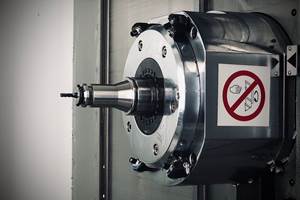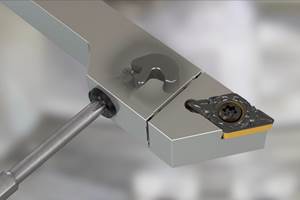Boosting Productivity For Turbine Engine Part Makers
Compared with common steel, the heat-resistant super alloys (HRSAs) and other hard metals used in jet engines and ground-based turbines require far longer cycle times per part. Advanced cutting inserts can boost machining throughput with these materials, but achieving these gains requires proper tooling selection and proper implementation.
Share





Compared with common steel, the heat-resistant super alloys (HRSAs) and other hard metals used in jet engines and ground-based turbines require far longer cycle times per part. Advanced cutting inserts can boost machining throughput with these materials, but achieving these gains requires proper tooling selection and proper implementation.
Cutting In Stages
The turning or milling of complex turbine parts progresses through first, intermediate and last stages. First-stage machining usually starts with large forgings that are often irregular in shape and covered with hard, abrasive scale. Intermediate steps conducted after the hard skin has been machined away account for about 80 percent of the material removed from turbine parts. Last-stage finish machining must achieve high tolerances on turbine components yet impart low stresses into thin structures.
In first-stage machining, the initial slow, rough-cutting pass so critical to producing a usable part is often complicated by interrupted cuts. Round insert geometries typically provide the best edge security in such applications. With no stress-raising corners, the circular shape is inherently strong.
As to grade selection, coated carbide inserts should be the cutting tools of choice. The carbide grade must withstand the shock of interrupted cuts while the insert edges survive the abrasion and micro-chatter brought on by the particle-filled skin. Inserts Sandvik Coromant offers for these applications have a hard fine-grain microstructure and thick titanium aluminum nitride coating. In turbine alloys, these features permit 10 to 40 percent greater productivity than more conventional carbide inserts can achieve.
Intermediate Cutting
Compared with slow first-stage machining, intermediate-stage machining provides turbine part manufacturers with a greater opportunity for fast metal removal. Taking advantage of this opportunity requires extra-hard cutting tool materials able to withstand high heat and abrasion to turn or mill turbine alloys at the most productive speeds and feed rates. In such applications, whisker-reinforced ceramic cutting inserts can sustain cutting speeds up to 1,000 sfm for 10 times the productivity of common carbide inserts. Careful orientation of the silicon carbide whiskers on the part of the cutting tool maker can deliver edge strength able to provide up to 20 percent greater productivity compared to other ceramics.
At high speeds, multiple passes on hard metals commonly cause edge notching of the insert, even on whisker ceramic inserts. However, ramping the insert—varying the depth of cut on successive passes—distributes wear along the cutting edge and extends edge life. It also reduces the risk of catastrophic edge failure midway through a cut.
An exception is made for titanium. Ceramic inserts at high cutting speeds generate too much heat to be used safely on this metal—the workpiece may combust. The optimum intermediate machining solution for titanium has proven to be coated carbide inserts at lower speeds.
The Final Cut
Final-stage machining refers to the last cutting passes made to achieve tight tolerances and fine finishes. Typically, final passes are done at low cutting speeds and shallow depths of cut. During this machining, thin-walled turbine components are vulnerable to machining stresses that can distort their shapes and shorten their fatigue lives. An extra-sharp insert used at a low feed rate can minimize cutting forces to protect these thin parts. A fine-grain coated carbide insert ground with a sharp finishing geometry machining a thin, hollow combustor ring made of Inconel 718 may be capable of 180 sfm and a feed rate of 0.004 ipr.
Another option is cubic boron nitride finishing tools. CBN puts little stress into thin parts. However, the edge security of the cutting insert is essential on large forgings, which can cost $250,000 or more. With edge temperatures exceeding 2,000°F, Inconel machining can be hot enough to melt the brazement holding the CBN tip in place.
Tip breakout has been a common problem leading many turbine manufacturers to shy away from CBN. However, one alternative is to sinter the CBN tips in place, eliminating brazing metal altogether. Further economy can come from inserts having multiple edges, substantially reducing the cost per edge. In place of uncoated carbide inserts, these tools can provide up to 10 times the productivity finishing hard HRSAs.
About the author: Mike Castner is director of rotating products for cutting tool supplier Sandvik Coromant.
Related Content
Indexable Drill Heads Double Profitability
Moving to a robust line of indexable drills enabled this shop to dramatically alter the manufacturing process for a problem part, doubling its profitability.
Read MoreHow to Troubleshoot Issues With Tool Life
Diagnosing when a tool is failing is important because it sets an expectation and a benchmark for improvements. Finding out why gives us a clue for how to fix it.
Read MoreQuick-Change Tool Heads Reduce Setup on Swiss-Type Turning Centers
This new quick-change tooling system enables shops to get more production from their Swiss turning centers through reduced tool setup time and matches the performance of a solid tool.
Read MoreInside the Process of Cutting Tool Recycling
Global Tungsten & Powders, part of the Ceratizit Group, sheds light on the processing steps that convert a shop’s used inserts into new tools and other applications.
Read MoreRead Next
AMRs Are Moving Into Manufacturing: 4 Considerations for Implementation
AMRs can provide a flexible, easy-to-use automation platform so long as manufacturers choose a suitable task and prepare their facilities.
Read MoreMachine Shop MBA
Making Chips and Modern Machine Shop are teaming up for a new podcast series called Machine Shop MBA—designed to help manufacturers measure their success against the industry’s best. Through the lens of the Top Shops benchmarking program, the series explores the KPIs that set high-performing shops apart, from machine utilization and first-pass yield to employee engagement and revenue per employee.
Read More




















